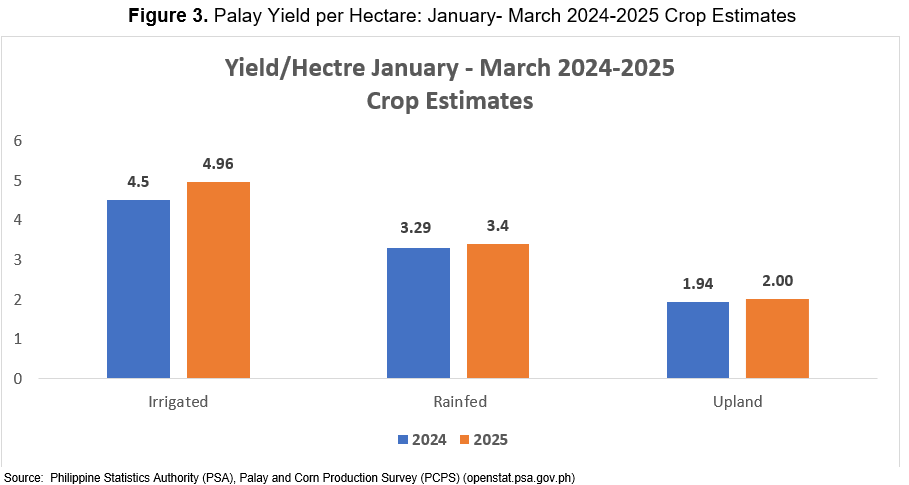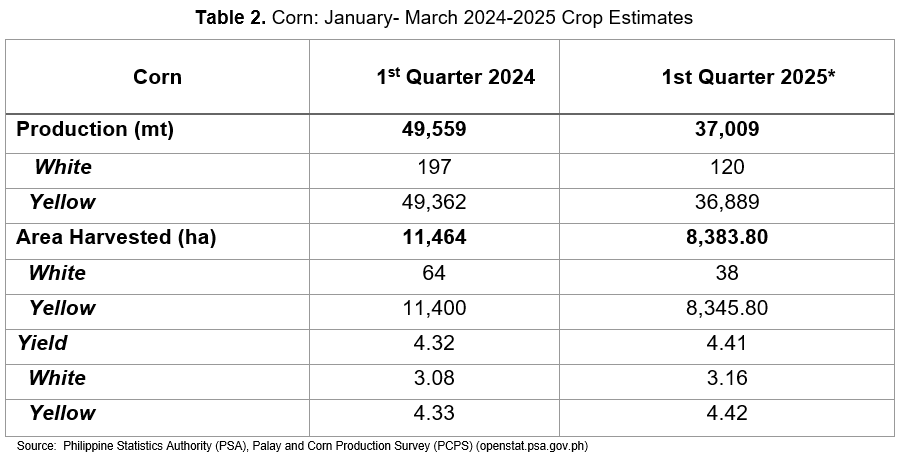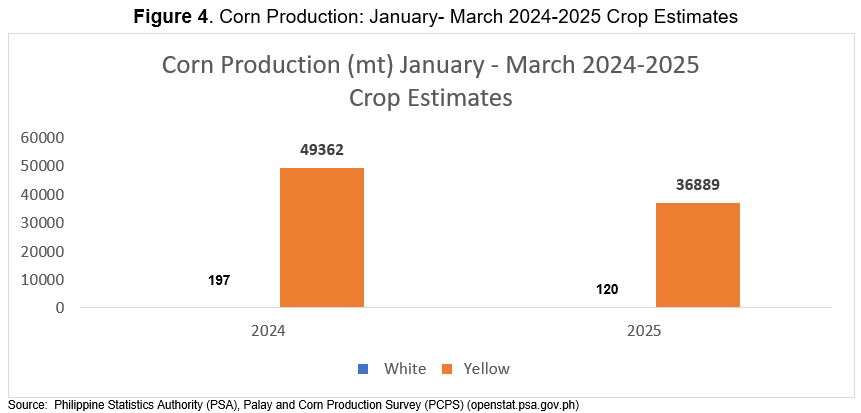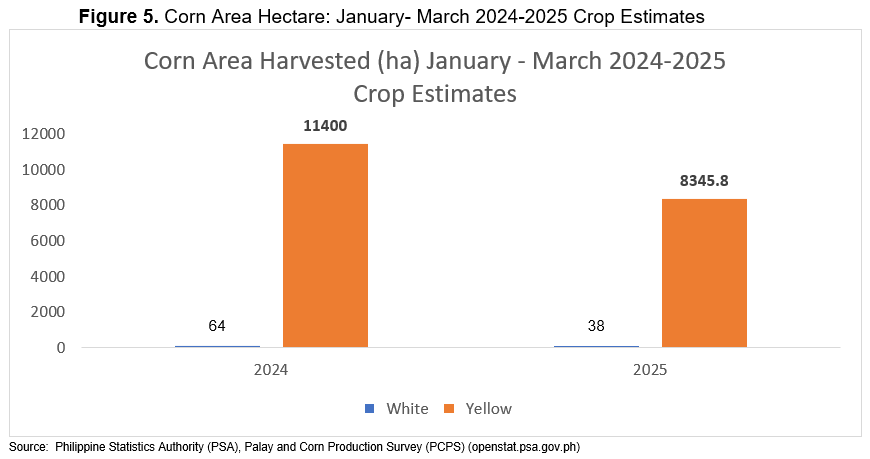
Palay and corn production estimates provide critical data on output, area harvested, and yield that serve as essential inputs for agricultural policymaking, GDP computation, and national food security planning, while also guiding programs to support farmers and stabilize rice and corn supply in the Philippines.
In the first quarter of 2025, Quirino Province’s palay production fell to 24,633.16 metric tons, marking a 7.1% decline from the previous year’s 26,526.00 metric tons. This drop was driven largely by a 15% contraction in harvested area, which shrank from 6,015.00 to 5,110.80 hectares. Despite the reduction in both output and cultivated land, farmers achieved higher productivity, with average yields climbing from 4.41 to 4.82 metric tons per hectare. While irrigated farms—still the dominant production source—saw declines in area and output, upland palay posted gains in both. Meanwhile, rainfed palay production remained steady, as detailed in Table 1.

Palay production in Quirino Province showed varied performance across different ecosystems in the first quarter of 2025. Irrigated areas experienced a notable decline, with output dropping from 25,644 metric tons in 2024 to 23,662.16 metric tons in 2025. This reduction was mainly due to prolonged rainfall and low temperatures, which adversely affected panicle development and resulted in fewer flowers being formed. In contrast, rainfed areas recorded a slight increase, rising from 684 to 697 metric tons, while upland areas saw a significant gain, increasing from 198 to 274 metric tons. These trends indicate that, although irrigated systems were negatively impacted by unfavorable weather, improvements in rainfed and upland production helped partially offset the overall decline in palay output, as shown in Figure 1 below.

In the first quarter of 2025, the area harvested for palay across different ecosystems in Quirino Province showed significant shifts. Irrigated areas decreased notably, from 5,705 hectares in 2024 to 4,768.80 hectares in 2025. In contrast, rainfed areas expanded substantially, increasing from 208 to 973 hectares, while upland areas grew modestly, from 102 to 137 hectares. The overall decrease in irrigated harvested area was largely due to late land preparation and delayed planting. Additionally, some areas that were newly planted or still in the vegetative stage during the typhoons in the last quarter of 2024 were replanted and are now expected to be harvested in the second quarter of 2025, as shown in Figure 2 below.

Palay yield per hectare across all ecosystems in Quirino Province improved. Irrigated areas increased from 4.50 tons/hectare in 2024 to 4.96, rainfed areas from 3.29 to 3.40, and upland areas from 1.94 to 2.00. This overall improvement was attributed to sufficient rainfall and adequate water supply, in contrast to the dry spell experienced during the same period last year, as shown in Figure 3 below.

Corn production in Quirino Province in the 1st quarter 2025 reached 37,009 metric tons, showing a decline from 49,659 metric tons in the same period in 2024. This decrease was accompanied by a reduction in the area harvested, which dropped from 11,464 hectares in 2024 to 8,383 hectares in 2025. Despite the lower production and smaller harvested area, the average yield per hectare improved slightly, rising from 4.32 MT/Ha in 2024 to 4.41 MT/Ha in 2025, indicating better productivity. The majority of the corn produced was of the hybrid variety, which accounted for 36,889 metric tons, as detailed in Table 2.

Quirino Province saw a decline in corn production in Q1 2025, with yellow corn dropping from 49,362 to 36,889 metric tons and white corn from 197 to 120 metric tons. The decrease was due to continuous rainfall causing saturated soils and delayed planting, with replanting efforts expected to boost output in the second quarter (Figure 4).

In Q1 2025, the area harvested for yellow corn in Quirino Province declined from 11,400 to 8,383.8 hectares, while white corn dropped from 64 to 38 hectares. This reduction was mainly due to uneven crop growth in floodplains and broad plains caused by continuous rainfall and cold weather in January–February. Nevertheless, both corn types benefited from sufficient water supply, as shown in Figure 5.

Yield per hectare for the 1st quarter 2025 for yellow corn in Quirino Province increased from 3.16 MT/Ha in 2024 to 4.42 MT/Ha, while white corn yield rose from 3.08 MT/Ha to 4.33 MT/Ha. This improvement was attributed to sustained soil moisture during the reproductive stage and the use of high-yielding corn varieties distributed by DA-RFO 02 and the PLGU.

Definitions of Terms
Crop Production - This refers to quantity produced and actually harvested during the reference period. It includes those harvested but damaged, stolen, given away, consumed, given as harvesters’ and threshers’ shares, reserved, etc.
Area harvested – This refers to the total area harvested to palay during the reference quarter. It may be less than or equal to the total area planted to palay.
Irrigated - Area with irrigation facilities supplying water through artificial means like gravity, force/power, pump, etc. Irrigated area become rainfed only, when the irrigation system is no longer operational for the past two (2) years and beyond repair and there is no plan of irrigating the farm.
Rainfed - Palay grown on this ecosystem has dikes that retain water and is solely
dependent upon rainfall for its water supply.
Upland - Palay grown on this ecosystem does not have amenities for standing water.
It is usually located along elevated lands, along rivers, between hills, hillsides, etc.
White Corn - This is a type of corn used primarily for human consumption.
Yellow Corn - This is a type of corn used generally as feed grains. It includes all types
of corn other than white.
ENGR. CHERRY GRACE D. AGUSTIN
Chief Statistical Specialist
msl/rdc
